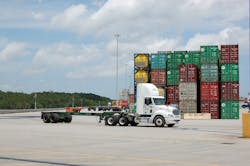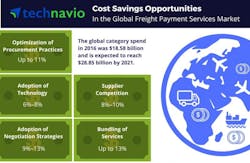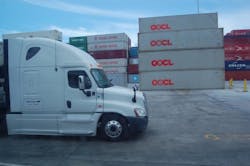The way pricing and payment for freight shipments around the world is shifting quickly to digital formats designed to ultimately provide more transparency into how cargo costs are compiled.
Yet in the eyes of several firms, this trend won’t necessarily lead to a more price-focused freight market. Rather, it could lead to a greater emphasis on customer service while at the same time lowering freight costs for shippers, transportation providers, logistics companies, and freight brokers alike.
“Freight digitalization is inevitable,” noted Zvi Schreiber, CEO and founder of online freight pricing provider Freightos. “Those … intent on providing good [freight] service have a lot to gain from digitalization. Far from the threat it was once perceived to be, it may in fact be their best bet for future-proofing their business.”
Freightos recently polled 70 major freight forwarders about this “digitalization” trend and its potential impact on the global cargo market. Here are some of the survey findings:
- Although freight forwarding is largely a manually-based business today, in five years’ time, 74% of those polled believe it will be largely (but not completely) automated, just like personal banking is today.
- Some 57% of forwarders today believe that shippers are driven by price to choose forwarders today. By 2022, though, they believe that will decrease to 35%, while the importance of customer service in selection will grow from 11% to 28%.
- By “service differentiation,” forwarders mean customer service (77%) or seamless operations (63%), not the scope of actual services. However, this “differentiation” doesn’t necessarily relate to “personal touch.” For while 77% of those polled agree that the “personal touch” is critical to the freight market today, they believe it will decrease to 54% by 2022.
- Digitalization paves a cost-effective path to customer service – as evident in the U.S trucking sector, according to those polled, where customer convenience drives cost cutting, not the other way around.
- Transparent ratings will change customer interactions as freight firms wanting to retain favorable ratings and reviews will be forced to differentiate themselves by providing a comprehensive customer focus – for instance, emulating an Amazon-level chat service.
- New Internet of Things (IoT) technologies, like tracking and monitoring, can transform traditional freight transportation firms into “omniscient consultants.” That role may expand to collaborating with shippers’ other partners across the entire supply chain, according to Freightos’ poll.
Those trends are also going to change how freight shipments are paid for, largely due to technology. According to a recent report by global consulting firm Technavio, the global freight payment services market is expected hot a compound average growth rate (CAGR) of 9.2% over the next five years; an increase that highlights the need for “cost-effective logistics solutions,” in the words of Angad Singh, the company’s lead procurement specialist.
“During the forecast period, the freight payment services market will be driven by increasing amount of outsourcing and globalization, which mandates the need to adhere to local payment regulations while doing business in the region,” Singh explained.
“In addition, the global freight payment services market is also experiencing growth in the adoption of technological innovations to reduce the scope of human error and optimize the level of services provided, which will further drive the market,” he added.
Some of the findings from Technavio’s report, entitled Global Freight Payment Services Market: Procurement Market Intelligence Report 2017-2021, include:
- Global freight payment services providers are investing in proprietary technology platforms to help store payment data and generate insights that reduce risks associated with managing large and complex supply chains across different geographies.
- Extensive analysis of the demand-supply shifts in the global freight payment services market by Technavio shows that buyers demand automation software for TMS [transportation management systems] and WMS [warehouse management systems] to better manage shipments, track utilization, analyze shipping patterns, and maintain scorecards on service quality and help reduce the transportation overheads.
- Suppliers are also leveraging Big Data and IoT to develop new services that enhance productivity and reduce cost for freight shipments.
- A major pain point: the “pilferage” of funds by suppliers as buyers entrust the freight payment service providers, plus the loss of control over certain operational areas such as timely payment to carriers.
- Thus the timely auditing of freight payments externally will become critical. Moreover, shipment tracking software will be assessed going forward for more “transportation visibility” to overcome the challenge of loss of control of payments.
Big money is at stake here, according to industry data, especially in terms of the cost savings potential due to digitalization.
Technavio recently quantified potential savings from data analytics, e-freight, web portals, and cloud-based systems, noting that enhanced operational efficiency, on-time delivery, and improved satisfaction could yield up to 12% potential savings for forwarders.
Similarly, the World Economic Forum projects logistics savings of up to $789 billion by 2025 due to those trends.Yet Freightos’ Schreiber noted that reducing freight costs alone won’t be the major “end point” of this digitalization trend.
“Digitalization will erode service differentiation, leading to commoditization and a race to the bottom,” he stressed.
“[But] forwarders [surveyed by Freightos] predict that within five years, shippers will no longer be predominantly price driven. Digitalization and transparency will help forwarders better focus on customers, triggering a service race, not a price race.”
That analysis dovetails with some of the findings from the 12th annual survey of 2,000 shippers that use LTL services conducted by Mastio & Co.
In a recent conference call hosted by Stifel Capital Markets, Mastio’s Kevin Huntsman noted that the biggest reasons shippers cited for switching to a new motor carrier fell into two “main buckets” overall: communication and service execution. Other reasons cited “regularly” included unfriendly customer service representatives, lengthy claims processes, hard-to-reach customer service reps when issues arrive, not being told when there is a problem, on-time pickup/delivery issues, cargo damage, actual invoice charges that are different from initial quotes, and the inability to help track shipments.
Shippers said in Mastio’s survey that investments by motor carriers in technology and well as in customer service were “most important,” yet the firm noted that “operational investments” are likely more important as they help prevent late pickups and cargo damages.
“Because what shippers really want is their freight picked up on-time, delivered on-time and damage-free; all at a fair price,” Huntsman noted.
About the Author
Sean Kilcarr
Editor in Chief
Sean Kilcarr is a former longtime FleetOwner senior editor who wrote for the publication from 2000 to 2018. He served as editor-in-chief from 2017 to 2018.


